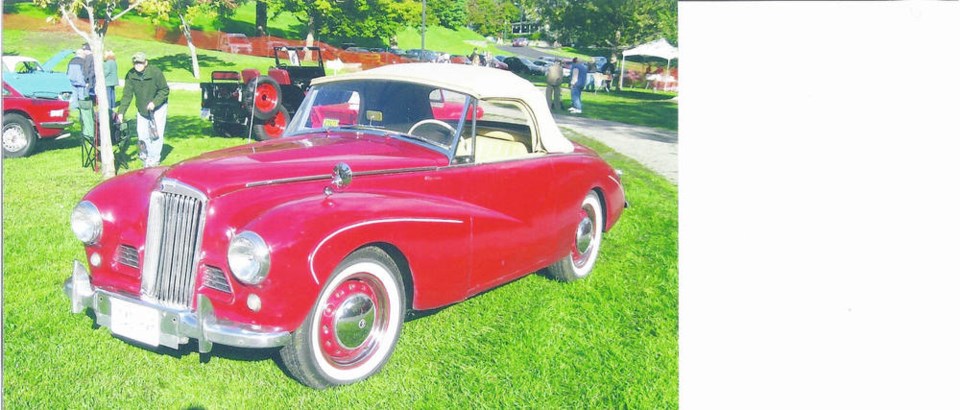Sunbeam’s history began in 1899 when John Marston Ltd., a tin-plater and bicycle manufacturer of Wolverhamptom, Staffordshire, England, built two small prototype cars.
Their designer, Thomas Cureton, took over the automobile part of the business and the first Sunbeam car with a horizontal, one cylinder engine was launched in 1900.
In 1901, the company produced the unusual Sunbeam-Mabley with its wheels deployed in a diamond pattern: one front, one back, and one on each side. This soon gave way to a conventional layout, basically the French Berliet car with a Sunbeam name. Sunbeam Motor Car Co. became a separate entity in 1905 and began developing cars of its own design.
The company produced a variety of models and in 1920 joined the French Talbot-Darracq Co. to become Sunbeam-Talbot-Darracq. Sunbeam’s already successful competition program was stepped up and it won the 1923 French Grand Prix, Britain’s first Grand Prix win. It also held the world’s land speed record five times from 1922 to 1927.
Sunbeam-Talbot-Durracq enterprise floundered during the Depression and by the mid-1930s was in receivership. It was taken over by the Rootes Group in 1935 and Sunbeams became an amalgam of Rootes’s Humber and Hillman cars.
In spite of this long and occasionally glorious past, most North Americans became familiar with the Sunbeam name through the sporty Sunbeam-Talbot and derivative Sunbeam Alpine of the early 1950s
The Sunbeam-Talbot bowed at the 1948 London Motor Show as the series 80 and 90. The 80 with an overhead valve version of the Hillman Minx engine was soon discontinued.
A much-improved 90 Mark II came in 1950, now with the Humber Hawk’s independent coil spring front suspension replacing leaf springs and solid axle. The overhead valve engine was enlarged from 1,944 cc (118 cu in.) to 2,267 cc (138 cu in.), and being a pre-war design it had a long stroke (110 mm; 4.33 in.) and small bore (81 mm; 3.18 in.). The Mark II was exported to North America.
Recalling Sunbeam’s glory days and recognizing the sales value of competition success, Rootes established a Sunbeam competition department in 1949. It paid off when the Sunbeam-Talbot team took three Coupes des Alpines awards and the manufacturer’s team prize in the 1952 Alpine Rally. This was the first of many Talbot/Alpine rallying successes that culminated in an outright Alpine Rally win in 1955.
When the Sunbeam-Talbot 90 sedan and four-passenger convertible reached North America its performance was found moderate for a sporty type car. Road & Track (8/51) reported zero to 60 mph (97 km/h) in 20.2 seconds for the 1,235 kg (2,723 lb) convertible, and top speed of 140 km/h (87 mph). They called it “a very good blending of ‘streamlined’ and ‘traditional’ design.”
Although the Talbot’s performance was adequate, Rootes recognized the need for a sportier image and better performance so the new two-seater Sunbeam Alpine (named for the Alpine Rally) was introduced in 1953. Higher compression increased horsepower to 77 from the Talbot’s 70.
The Alpine was more sporty car than sports car, which Road & Track summed up as “… somewhat of a paradox. From (and including) the dash forward the car was identical to the 90 series sedans and convertibles. It was a Talbot from the cowl forward, with a sleeker tapered tail grafted on. The sloping, ridged tail fell sharply away from the two single seats.”
To prove the Alpine’s sporting potential the company tuned an engine to 105 horsepower, and with windshield removed and a bellypan added it exceeded 193 km/h (120 mph) on Belgium’s famous Jabbeke highway. At France’s Montlhery circuit it averaged 179 km/h (111.2 mph) for an hour.
Although sportier than the Talbot and with horsepower now up to 80 the Alpine’s performance was little improved because the extra power was pretty well cancelled by a 130 kg (287 lb) weight increase. Road & Track (3/54) reported the Alpine’s zero to 60 (97) time marginally quicker at 19.0 seconds and top speed virtually unchanged at 139 km/h (86.6 mph).
In spite of company claims, the Alpine could not really be called a sports car. Being based on the Sunbeam Talbot made it higher and less rakish than real sports cars like the Austin-Healey, Triumph or MG. It was a sporty touring car, but with one advantage that made sports car owners envious: a 14 cubic foot trunk.
Although never very fast, the Sunbeam Alpine was an attractive and luxurious tourer that combined a certain exclusivity with a grand old name.
Production of the first generation Sunbeam Talbot-derived Alpine ceased in 1955 and the 90 in 1956. A true Sunbeam Alpine sports car would come for 1960, and would finally get the performance it always needed with the appearance of the Ford V-8 powered Sunbeam Tiger in 1964.



